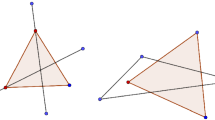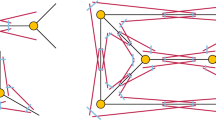Abstract
The problem of triangulating a polygon using the minimum number of triangles is treated. We show that the minimum number of triangles required to partition a simplen-gon is equal ton+2w −d − 2, wherew is the number of holes andd is the maximum number of independent degenerate triangles of then-gon. We also propose an algorithm for constructing the minimum triangulation of a simple hole-freen-gon. The algorithm takesO(nlog2 n+DK 2) time, whereD is the maximum number of vertices lying on the same line in then-gon andK is the number of minimally degenerate triangles of then-gon.
Similar content being viewed by others
References
T. Asano, T. Asano, and Y. Ohsuga,Partitioning a polygonal region into a minimum number of triangles, The Transactions of the IECE of Japan, Vol. E 67, No. 4 (1984), pp. 232–233.
T. Asano, T. Asano, and R. Y. Pinter,Polygon triangulation: efficiency and minimality, Journal of Algorithms, Vol. 7, No. 2 (1986), pp. 221–231.
B. M. Chazelle,A theorem for polygon cutting with applications, Proceedings of the 23rd IEEE Annual Symposium on the Foundations of Computer Science (1983), pp. 339–349.
B. M. Chazelle and L. J. Guibas,Visibility and intersection problems in plane geometry, Discrete Computational Geometry, Vol. 4, No. 6 (1989), pp. 551–581.
A. Fournier and D. Y. Montuno,Triangulating simple polygons and equivalent problems, ACM Transactions on Graphics, Vol. 3, No. 2 (1984), pp. 153–174.
M. R. Garey, D. S. Johnson, F. P. Preparata, and R. E. Tarjan,Triangulating a simple polygon, Information Processing Letters, Vol. 7, No. 4 (1978), pp. 175–179.
A. Lingas,The power of non-rectilinear holes, Proceedings of the 9th Colloquium on Automata, Languages and Programming, Aarhus (1982), pp. 369–383.
J. O'Rourke,Art Gallery Theorems and Algorithms, Oxford University Press, Inc., New York (1987).
K. J. Supowit,Finding a maximum planar subset of a set of nets in a channel, IEEE Transactions on Computer-Aided Design, Vol. 6, No. 1 (1987), pp. 93–94.
R. E. Tarjan, and C. J. Van Wyk,An O(n loglog n)-time algorithm for triangulating a simple polygon, SIAM Journal on Computing, Vol. 17, No. 1 (1988), pp. 143–178.




